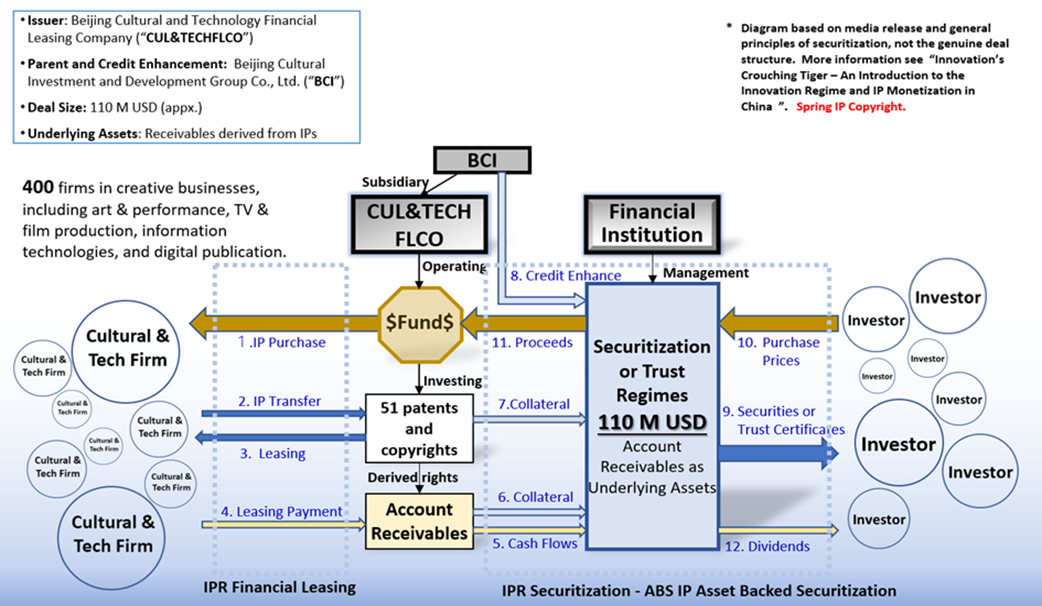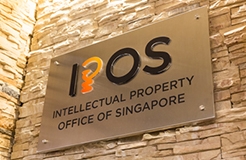Did not receive verification mail? Please confirm whether the mailbox is correct or not Re send mail

Vapor
- 2020-04-15 10:04:18
The New Era of IP Securitization in China

Securitization is the jewel in the crown of IP monetization. In 2019, following the success of the first deal, the China market has seen more than 10 IP securitization deals, with accumulated proceeds exceeding 10 Billion RMB.
The First Patent Securitization Deal Approved in China
As a break-through in her IP financing endeavor, China approved the first patent securitization deal on July 31, 2019. The deal size is 300 M RMB, securitizing the royalties from a pool of 107 invention patents and 37 utility patents held by 11 high-tech companies in Guangzhou Development District (the “Guangzhou Deal”).
The Guangzhou Deal is the 3rd IP securitization deal in a row and the first of its kind. The previous two deals were backed up by royalties from copyrights and various kinds of IPs, including copyrights, trademarks and patents. The Guangzhou Deal is solely backed up by patent royalties.
This is a break-through deal, because it is more difficult to evaluate a patent then other kinds of IP. The Guangzhou Deal also demonstrates that the development of the financial industry, the quality of patents, and the market appetite for IP securitization have reached a new level in China.
The Guangzhou Deal, together with other ground-breaking securitization deals in 2019, undoubtedly reveals a new era of IP monetization in China.
From Zero-breaking to 10 Billion Market in 2019
While the Guangzhou Deal is indeed a milestone, the China market saw its first IP securitization deal in early 2019. The deal structure of the first deal creatively resolved long-standing issues in IP valuation and paved the way for the Guangzhou Deal and many other IP securitization deals later in the year.
As illustrated in the chart below, in the first IP securitization deal, the issuer is Beijing Cultural and Technology Financial Leasing Company. Its parent company, Beijing Cultural Investment and Development Group Co., Ltd., provides credit enhancement through a guarantee. The deal size is about 110 M USD. The underlying assets for securitization are receivables derived from various IPs, mainly consisting of copyrights, some trademarks, and few patents in information technologies. The IPs are pooled from 400 firms in creative businesses, including art & performance, TV & film production, information technologies, and digital publication.
Although this is the first IP securitization deal in China, some commentators believe this deal is not a genuine “patent securitization” because patents were only a small portion of the underlying assets.
Leasing-back to mitigate valuation risks
However, the “leasing back model” used in this first IP securitization was quite creative and has made possible the first patent securitization mentioned above.
“Leasing-back” refers to “sale and lease back”, meaning that the IP owners sell their IP to the financier, and then the financier leases the same back to the original patent owners.
This arrangement helps to mitigate valuation risks in several ways.
First, when the IP is “sold” to the financer, it must be tagged with a price. This transaction is made for the purpose of the securitization, rather than in a normal course of business. However, this price is still determined in an arm-length transaction with assistance from a third-party valuer. Without such transaction, the parties would need to find a third-party valuer to determine the underlying IP. This leads to the issue in the second point below.
Second, the original IP owners know the genuine value of the IP better than anyone else. Insufficient domain knowledge has been a long-standing issue in IP valuation. To solve this issue is costly and sometimes impossible because an appraisal professional familiar with the industries of concern is usually rare. Many valuation technics can help. However, insights on the IP value may only come from an insider practicing the IP on a daily basis. Therefore, the perspective of the original IP owners is irreplaceable.
Interestingly, the leasing back arrangement checks and balances the interests of the original owners so that they would not ask for unreasonably high prices in selling their IP. If they do, they will need to pay a high rental to lease back these IP from the financier.
Third, a leasing back arrangement enables the original IP owners to continually utilize their IP. This ensures a more stable and predictable cash flow derived from utilization of the IP. IP has no standing alone value. There must be someone use his/her business skills to exploit the IP. Naturally, the original owners have the established experience and facilities to carry on such exploitation.
Acceleration into a New Era
After the success of the first deal, IP securitization deals has surged in 2019. According to a survey by Beijing Intellectual Wealth Group and (北京智慧财富集团), up to October 2019, the market has seen more than 10 IP securitization deals launched or waiting in line for approval, with accumulated proceeds amounting to more than 10 Billion RMB (according to a summary prepared by Beijing Intellectual Wealth Group on November 2019), including the historical first “pure” patent securitization deal (the Guangzhou Deal) mentioned above.
Meanwhile, leading professionals in the industry are gathering to form associations promoting IP securitization deals. For example, in November 2019, dozens of renown IP experts, leaders in financial and securities industries and representatives from innovative companies gathered in Beijing to announce the “Initiatives by 50 Pioneers’ Forum for IP Securitization” (中国知识产权证券化50人论坛倡议书), which benchmarks the arrival of the IP securitization new era in China.
(Dr. Jili Chung is currently working in Greater China. He is the founder of SpringIP Group, dedicated to foster enterprises’ innovation through AI and Big Data tools. Carlo Geremia, a cross-border transaction expert residing in Shanghai and Italy has also contributed to this article.)

Chart: Step-by-step Illustration of First IP Securitization in China
1. The issuer maintains a fund and use it to acquire the IPs from the original owners, i.e., 400 companies in the culture, creative and information technologies industries.
2. The ownership of the IP (51 patents and copyrights) are transferred to the issuer.
3. The issuer leases the IP back to the original owners. (Accordingly, the original owners can continue exploiting the IPs.)
4. The original owners pay rental fees to the issuer. This periodical rental payments become the account receivables (cash flows) to the issuer.
5. The issuer assigns the rights to future cash flow generated from the account receivables to a special purpose vehicle (SPV) used to issue securities.
6. The issuer pledges the accounts receivable of the periodical rental payments to the SPV. (In case the cash flow falls below the promised level, the SPV may dispose the collateral in exchange for the liquidity).
7. The issuer pledges the IP as collateral to the SPV. (In case the cash flow falls below the promised level, the SPV may dispose the collateral in exchange for the liquidity).
8. The issuer’s parent company, a giant group company with strong financial resources, provides a guarantee that the issuer will fulfil the cash flow up to the promised level or otherwise the issuer’s parent company will fill in the gap.
9. The SPV issues securities to the investors with terms and amounts matching the promised cash flows.
10. The investors pay for and acquire the securities.
11. The payment from the investors for the securities become the proceeds of the SPV.
Source: iprdaily.com
Author:Jili Chung
Editor:Vapor
- I also said the two sentence
- Also you can enter 140words






